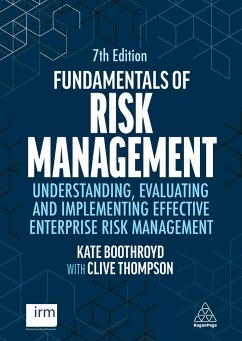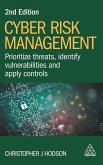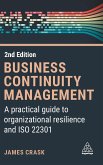Kate Boothroyd, Clive Thompson
Fundamentals of Risk Management
Understanding, Evaluating and Implementing Effective Enterprise Risk Management
Kate Boothroyd, Clive Thompson
Fundamentals of Risk Management
Understanding, Evaluating and Implementing Effective Enterprise Risk Management
- Gebundenes Buch
- Merkliste
- Auf die Merkliste
- Bewerten Bewerten
- Teilen
- Produkt teilen
- Produkterinnerung
- Produkterinnerung
Gain a complete understanding of the core concepts, frameworks and strategies of enterprise risk management with this comprehensive text for students and risk professionals.
Andere Kunden interessierten sich auch für
![Cyber Risk Management Cyber Risk Management]() Christopher J HodsonCyber Risk Management175,99 €
Christopher J HodsonCyber Risk Management175,99 €![Business Continuity Management Business Continuity Management]() James CraskBusiness Continuity Management174,99 €
James CraskBusiness Continuity Management174,99 €![Green and Sustainable Finance Green and Sustainable Finance]() Simon ThompsonGreen and Sustainable Finance200,99 €
Simon ThompsonGreen and Sustainable Finance200,99 €![Data Analysis for Business, Economics, and Policy Data Analysis for Business, Economics, and Policy]() Gábor BékésData Analysis for Business, Economics, and Policy208,99 €
Gábor BékésData Analysis for Business, Economics, and Policy208,99 €![Crisis Management in the Tourism Industry Crisis Management in the Tourism Industry]() Dirk GlaesserCrisis Management in the Tourism Industry239,99 €
Dirk GlaesserCrisis Management in the Tourism Industry239,99 €![Islamic Finance, Risk-Sharing and Macroeconomic Stability Islamic Finance, Risk-Sharing and Macroeconomic Stability]() Islamic Finance, Risk-Sharing and Macroeconomic Stability119,99 €
Islamic Finance, Risk-Sharing and Macroeconomic Stability119,99 €![Halal Cryptocurrency Management Halal Cryptocurrency Management]() Halal Cryptocurrency Management75,99 €
Halal Cryptocurrency Management75,99 €-
-
-
Gain a complete understanding of the core concepts, frameworks and strategies of enterprise risk management with this comprehensive text for students and risk professionals.
Hinweis: Dieser Artikel kann nur an eine deutsche Lieferadresse ausgeliefert werden.
Hinweis: Dieser Artikel kann nur an eine deutsche Lieferadresse ausgeliefert werden.
Produktdetails
- Produktdetails
- Verlag: Kogan Page / Kogan Page Ltd
- Seitenzahl: 472
- Erscheinungstermin: 31. Dezember 2024
- Englisch
- Abmessung: 250mm x 175mm x 30mm
- Gewicht: 987g
- ISBN-13: 9781398618688
- ISBN-10: 1398618683
- Artikelnr.: 70158757
- Herstellerkennzeichnung
- Libri GmbH
- Europaallee 1
- 36244 Bad Hersfeld
- gpsr@libri.de
- Verlag: Kogan Page / Kogan Page Ltd
- Seitenzahl: 472
- Erscheinungstermin: 31. Dezember 2024
- Englisch
- Abmessung: 250mm x 175mm x 30mm
- Gewicht: 987g
- ISBN-13: 9781398618688
- ISBN-10: 1398618683
- Artikelnr.: 70158757
- Herstellerkennzeichnung
- Libri GmbH
- Europaallee 1
- 36244 Bad Hersfeld
- gpsr@libri.de
Kate Boothroyd with Clive Thompson
Chapter
00: Introduction Chapter
01: What risk is and why it is important; Section
ONE: Introduction to risk management; Chapter
02: The evolution of risk management; Chapter
03: Risk management standards; Section
TWO: Enterprise risk management; Chapter
04: Enterprise risk management; Chapter
05: Risk management aims and principles; Chapter
06: Risk management framework
risk architecture, strategy and protocols; Chapter
07: Roles, responsibilities and documentation; Chapter
08: Risk management process; Chapter
09: Implementing enterprise risk management; Section
THREE: Defining context and objectives and assessing risk; Chapter
10: Understand the context; Chapter
11: Stakeholders; Chapter
12: Setting objectives; Chapter
13: Assessing risks
risk identification and articulation; Chapter
14: Classifying risks; Chapter
15: Assessing risks
risk analysis; Chapter
16: Different lenses for prioritizing risk; Chapter
17: Assessing risks
risk evaluation; Section
FOUR: Risk response and monitor, review and report; Chapter
18: Managing risk; Chapter
19: Controlling both threats and opportunities; Chapter
20: Ongoing monitoring; Chapter
21: Ongoing review; Chapter
22: Reporting on risk management; Section
FIVE: Risk strategy and culture; Chapter
23: Culture and behaviours; Chapter
24: Risk culture models and success factors; Chapter
25: Risk appetite and tolerance; Chapter
26: Risk appetite criteria and statements; Section
SIX: Corporate governance and assurance; Chapter
27: Introducing corporate governance; Chapter
28: Compliance and the control environment; Chapter
29: Risk assurance; Section
SEVEN: Organisational environment, resilience and sustainability; Chapter
30: Strategy and risk management; Chapter
31: Resilience and risk management; Chapter
32: Surviving shocks and disruption; Chapter
33: Sustainability and the risk management; Chapter
34: ESG and climate change; Section
EIGHT: Different approaches; Chapter
35: Different approaches to risk management; Chapter
36: Banking, insurance and operational approaches to risk management; Chapter
37: Project, health and safety, legal, supply chain and IT approaches to risk management; Chapter
38: ERM as a translation tool; Section
NINE: Adding value; Chapter
39: Maturity and continual improvement; Chapter
40: How risk management adds value; Chapter
41: Risk practitioner competencies; Chapter
42: How risk practitioners add value
00: Introduction Chapter
01: What risk is and why it is important; Section
ONE: Introduction to risk management; Chapter
02: The evolution of risk management; Chapter
03: Risk management standards; Section
TWO: Enterprise risk management; Chapter
04: Enterprise risk management; Chapter
05: Risk management aims and principles; Chapter
06: Risk management framework
risk architecture, strategy and protocols; Chapter
07: Roles, responsibilities and documentation; Chapter
08: Risk management process; Chapter
09: Implementing enterprise risk management; Section
THREE: Defining context and objectives and assessing risk; Chapter
10: Understand the context; Chapter
11: Stakeholders; Chapter
12: Setting objectives; Chapter
13: Assessing risks
risk identification and articulation; Chapter
14: Classifying risks; Chapter
15: Assessing risks
risk analysis; Chapter
16: Different lenses for prioritizing risk; Chapter
17: Assessing risks
risk evaluation; Section
FOUR: Risk response and monitor, review and report; Chapter
18: Managing risk; Chapter
19: Controlling both threats and opportunities; Chapter
20: Ongoing monitoring; Chapter
21: Ongoing review; Chapter
22: Reporting on risk management; Section
FIVE: Risk strategy and culture; Chapter
23: Culture and behaviours; Chapter
24: Risk culture models and success factors; Chapter
25: Risk appetite and tolerance; Chapter
26: Risk appetite criteria and statements; Section
SIX: Corporate governance and assurance; Chapter
27: Introducing corporate governance; Chapter
28: Compliance and the control environment; Chapter
29: Risk assurance; Section
SEVEN: Organisational environment, resilience and sustainability; Chapter
30: Strategy and risk management; Chapter
31: Resilience and risk management; Chapter
32: Surviving shocks and disruption; Chapter
33: Sustainability and the risk management; Chapter
34: ESG and climate change; Section
EIGHT: Different approaches; Chapter
35: Different approaches to risk management; Chapter
36: Banking, insurance and operational approaches to risk management; Chapter
37: Project, health and safety, legal, supply chain and IT approaches to risk management; Chapter
38: ERM as a translation tool; Section
NINE: Adding value; Chapter
39: Maturity and continual improvement; Chapter
40: How risk management adds value; Chapter
41: Risk practitioner competencies; Chapter
42: How risk practitioners add value
Chapter
00: Introduction Chapter
01: What risk is and why it is important; Section
ONE: Introduction to risk management; Chapter
02: The evolution of risk management; Chapter
03: Risk management standards; Section
TWO: Enterprise risk management; Chapter
04: Enterprise risk management; Chapter
05: Risk management aims and principles; Chapter
06: Risk management framework
risk architecture, strategy and protocols; Chapter
07: Roles, responsibilities and documentation; Chapter
08: Risk management process; Chapter
09: Implementing enterprise risk management; Section
THREE: Defining context and objectives and assessing risk; Chapter
10: Understand the context; Chapter
11: Stakeholders; Chapter
12: Setting objectives; Chapter
13: Assessing risks
risk identification and articulation; Chapter
14: Classifying risks; Chapter
15: Assessing risks
risk analysis; Chapter
16: Different lenses for prioritizing risk; Chapter
17: Assessing risks
risk evaluation; Section
FOUR: Risk response and monitor, review and report; Chapter
18: Managing risk; Chapter
19: Controlling both threats and opportunities; Chapter
20: Ongoing monitoring; Chapter
21: Ongoing review; Chapter
22: Reporting on risk management; Section
FIVE: Risk strategy and culture; Chapter
23: Culture and behaviours; Chapter
24: Risk culture models and success factors; Chapter
25: Risk appetite and tolerance; Chapter
26: Risk appetite criteria and statements; Section
SIX: Corporate governance and assurance; Chapter
27: Introducing corporate governance; Chapter
28: Compliance and the control environment; Chapter
29: Risk assurance; Section
SEVEN: Organisational environment, resilience and sustainability; Chapter
30: Strategy and risk management; Chapter
31: Resilience and risk management; Chapter
32: Surviving shocks and disruption; Chapter
33: Sustainability and the risk management; Chapter
34: ESG and climate change; Section
EIGHT: Different approaches; Chapter
35: Different approaches to risk management; Chapter
36: Banking, insurance and operational approaches to risk management; Chapter
37: Project, health and safety, legal, supply chain and IT approaches to risk management; Chapter
38: ERM as a translation tool; Section
NINE: Adding value; Chapter
39: Maturity and continual improvement; Chapter
40: How risk management adds value; Chapter
41: Risk practitioner competencies; Chapter
42: How risk practitioners add value
00: Introduction Chapter
01: What risk is and why it is important; Section
ONE: Introduction to risk management; Chapter
02: The evolution of risk management; Chapter
03: Risk management standards; Section
TWO: Enterprise risk management; Chapter
04: Enterprise risk management; Chapter
05: Risk management aims and principles; Chapter
06: Risk management framework
risk architecture, strategy and protocols; Chapter
07: Roles, responsibilities and documentation; Chapter
08: Risk management process; Chapter
09: Implementing enterprise risk management; Section
THREE: Defining context and objectives and assessing risk; Chapter
10: Understand the context; Chapter
11: Stakeholders; Chapter
12: Setting objectives; Chapter
13: Assessing risks
risk identification and articulation; Chapter
14: Classifying risks; Chapter
15: Assessing risks
risk analysis; Chapter
16: Different lenses for prioritizing risk; Chapter
17: Assessing risks
risk evaluation; Section
FOUR: Risk response and monitor, review and report; Chapter
18: Managing risk; Chapter
19: Controlling both threats and opportunities; Chapter
20: Ongoing monitoring; Chapter
21: Ongoing review; Chapter
22: Reporting on risk management; Section
FIVE: Risk strategy and culture; Chapter
23: Culture and behaviours; Chapter
24: Risk culture models and success factors; Chapter
25: Risk appetite and tolerance; Chapter
26: Risk appetite criteria and statements; Section
SIX: Corporate governance and assurance; Chapter
27: Introducing corporate governance; Chapter
28: Compliance and the control environment; Chapter
29: Risk assurance; Section
SEVEN: Organisational environment, resilience and sustainability; Chapter
30: Strategy and risk management; Chapter
31: Resilience and risk management; Chapter
32: Surviving shocks and disruption; Chapter
33: Sustainability and the risk management; Chapter
34: ESG and climate change; Section
EIGHT: Different approaches; Chapter
35: Different approaches to risk management; Chapter
36: Banking, insurance and operational approaches to risk management; Chapter
37: Project, health and safety, legal, supply chain and IT approaches to risk management; Chapter
38: ERM as a translation tool; Section
NINE: Adding value; Chapter
39: Maturity and continual improvement; Chapter
40: How risk management adds value; Chapter
41: Risk practitioner competencies; Chapter
42: How risk practitioners add value









